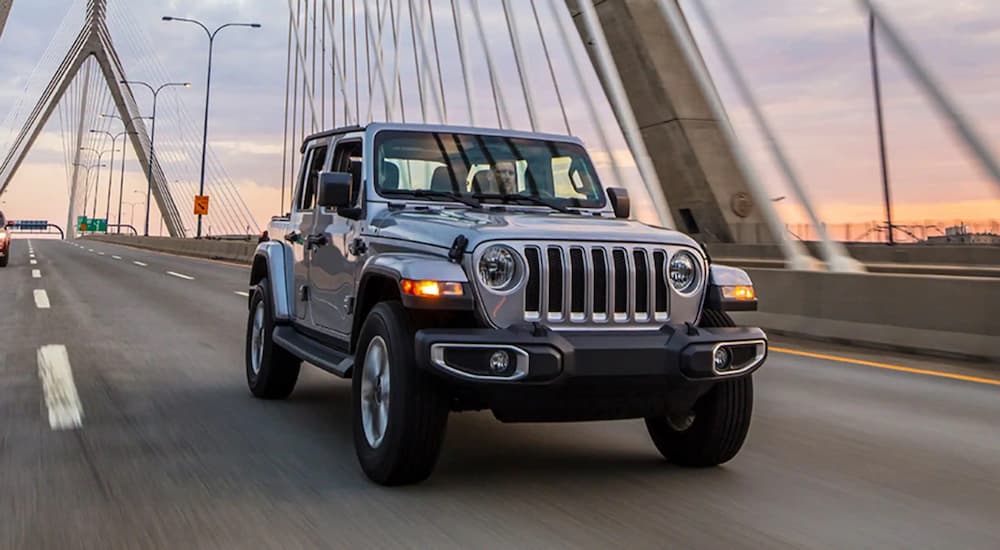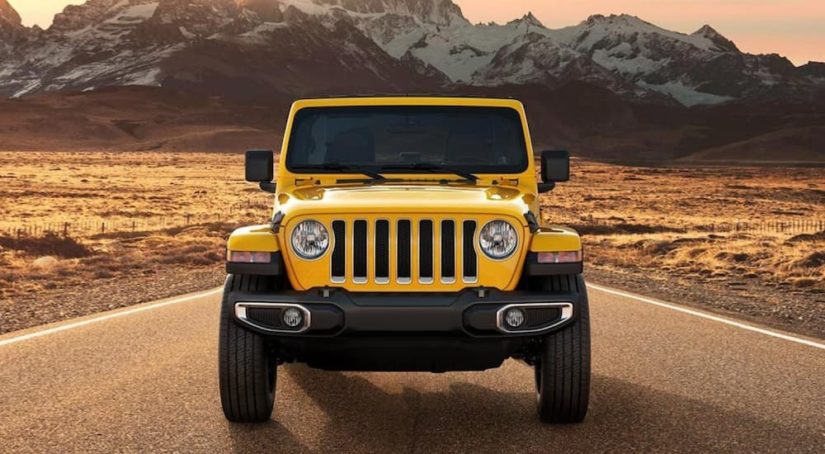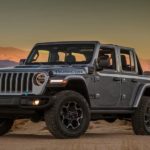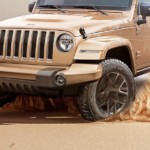We all want a vehicle that’s worth our time and money. Jeep, in particular, produces some of the finest automobiles on the market, but with new vehicles arriving every year, what of the older models? Used Jeep Wrangler buyer’s guides sometimes may not cover the extent of it all. You see, there have been four generations of the Wrangler to date, and each of them has brought forth numerous changes that keep the Wrangler in line with the most popular vehicles on the market.
It all started in 1987 with the first-generation Wrangler, and since then, we’ve seen the Wrangler adapt from a two-door SUV to a larger tech-heavy four-door SUV (though two-door models are still around). With that said, it’s easy to differentiate a Wrangler YJ from a JL, mostly stemming from the headlight design of the vehicle. The YJ doesn’t utilize the rounded headlights that have become a staple of the brand since then, while the headlights on the YJ are more squared-off.
But what do these generations ultimately mean? Also, does purchasing a Wrangler from a prior generation mean that you’re missing out on a majority of the modern-day Wrangler experience? After all, there is nearly a decade between generation releases.
YJ (1987-1996)
The Wrangler is nowhere near Jeep’s first vehicle; that honor goes to the 1940s Willys Quad, a 4×4 that the US army invested heavily in during World War II. That model, though, was loved by all who drove it so much that Jeep released a model to the general public. It was called the CJ Jeep or “Civilian Jeep.”
While the Jeep CJ was being made, the automotive scene was rapidly changing, and some of the most popular models of our time were first released. Among the many models released during this time that we still love today include the Ford Bronco, Jeep Wagoneer, Ford Mustang, and Chevy Impala. The Wrangler is no exception to this, born from the popular CJ model and evolving into the beast it is today.
First released in 1986, the Wrangler YJ was a strong and capable SUV that shared some of its design philosophy with the legendary Jeep CJ, which was already an inspiration from the Willys MB. From a visual standpoint, the YJ Wrangler models had an iconic appearance with their boxy design that was available in either an SUV configuration or a convertible more akin to the earlier Willy MB models. One look at the modern-day Wranglers, and it’s clear that the inspiration behind its design still influences them today. The YJ, in particular, has those squared-off headlights that we mentioned earlier.
For the time, the Wrangler brought forth a decent amount of power in a well-constructed chassis, and these early models could create between 103 to 183 hp within this generation and between 172 to 298 lb-ft of torque. Although basic by today’s standards, it was the start of something great nonetheless. At this point, it was obvious that the Wrangler was aimed at the thrillseekers and not your average 9-to-5 commuter.
![]()
TJ (1997-2006)
Exactly ten years after the release of the YJ, it was time for a makeover. The automotive industry had seen several advancements within the YJ’s time in the market. Vehicles became smarter, more efficient, and of course, stronger. Because of this, Jeep knew that the Wrangler needed some extra juice if it wanted to remain a solid competitor. There’s a wide range of Jeep enthusiasts who still attest to this day that there has never been a more prominent Wrangler than the TJ models. From various accounts, this doesn’t appear to be rose-tinted nostalgia either.
The Wrangler TJ retained its famous powertrains throughout its tenure, which included a 4.0L V6 engine. Due to laws changing surrounding engines and their emission outputs within this time, old-school Jeep enthusiasts have been able to tangibly notice a difference by simply operating the vehicle.
Ultimately, it’s the power behind the TJ models that regard it amongst these enthusiasts, and understandably so. The Wrangler overall felt more matured by this point, which lends itself to stellar off-roading experiences, a familiar design with the beloved round headlamps, and it is far cheaper on the used market nowadays. As any off-roading-focused vehicle should, the Wrangler includes a built-in 4×4 and a reworked suspension system. All we can say is that we salute those who try to go off
-road without these features.
The Wrangler TJ was on the market between 1996 and 2006, giving it a similar amount of time on the market as its predecessor, the YJ. Wrangler TJ models offered more power than their predecessors, too, thanks in part to an available 4.0L V6 engine. While the launch of the TJ may seem like ages ago, they’re not as irrelevant as you may think. This is especially true of later models such as the 2006 Wrangler, which can make a great choice for first-time drivers.
JK (2007-2017)
Following the TJ came the Wrangler JK, and this generation was in production the longest. The succeeding generation would not launch for over a decade as opposed to the nine-year release schedule we had seen up until this point. For the first time in history, this Wrangler generation was available with four doors along with the two-door configuration that had been a staple since its earliest days in production. Several benefits would arise from this, most notably is its potential for catering to a range of drivers. Four-door models would cement the Wrangler as the definitive choice for both new and pre-existing Jeep fans that drive with their families but enjoy engaging in off-roading activities on the side.
The Wrangler JK models remain highly relevant in today’s market, and if you take one drive downtown, you’re more than likely to see a handful of them on the road. A slight curvature of the grille is a telltale sign of a JK model, but the JK is likely to be Jeep’s best-selling Wrangler for a couple of reasons. Because the JK was on the market for such a long time, more of them were likely produced than any other generation of Wranglers thus far. Above all else, the number of new drivers on the road never decreases, and new Jeep fans are formed annually. Off-roading on a budget is the current focus of the earliest JK models, and adding modern-day technology such as infotainment centers, premium audio systems, and dual-zone climate control, among others, is what you can expect with later JK models.
Regarding performance, Jeep both simplified and amplified the pre-existing powertrains to one. Models such as the 2017 Wrangler include a 3.6L V6 engine paired to either a 6-speed manual or 5-speed automatic transmission. This engine was a point of contention between Wrangler enthusiasts, and this is due to this being a generally smaller engine compared to the one found in the cheaper TJ models.

JL (2018-Present)
We finally arrive at the JL, which is currently the latest generation of Wrangler models to be released. By this point, the Wrangler had received several upgrades that put it in line with other off-roading SUVs in regards to technology, safety, and performance. Here, you’ll find safety features such as a forward collision warning and blindspot monitoring, and new tech has been implemented, such as a 4G LTE Wi-Fi hotspot. Considering all of these new tech and safety features, off-roading with the JL is the safest that it has ever been with the Wrangler.
Performance is an important one as the aforementioned 3.6L V6 engine that was available on the JK models is still here and was further complemented by a new turbocharged 2.0L I-4. However, the 5-speed automatic transmission that would be paired with the V6 on those earlier models is now paired with a 6-speed manual instead.
During this generation of the Wrangler, a diesel was added. Starting with the 2020 Wrangler, a turbo diesel 3.0L V6 engine was available, and this gave off-roaders an option that gave the most torque and best fuel efficiency ever seen for the Wrangler. The resulting specs of this diesel engine were 260 hp and a whopping 442 lb-ft of torque.
This generation of the Wrangler also saw tremendous advancements in the form of the Rubicon 392 and the 4xe plug-in hybrid. The Rubicon 392 is undoubtedly the most powerful Wrangler to have ever existed, and this was because of its included 6.4L V8 that offers both 470 hp and torque. Additionally, the Rubicon 392 retained the off-roading amenities but includes a powertrain that allows for a 0-60 mph acceleration time in only 4.5 seconds.
The plug-in hybrid also brought with it a highly impressive performance with its turbocharged 2.0L 4-cylinder engine that combines with a 17 kWh battery, and the powertrain comes with an 8-speed automatic transmission. Plug-in hybrid off-road vehicles aren’t entirely too common, as you may know, but the Wrangler’s take on the concept exceeds expectations with 375 hp and 470 lb-ft of torque. When driving a Wrangler 4xe, you should expect a mileage range of 370 miles on a full charge and gas tank. Nowadays, the Wrangler Rubicon 392 and 4xe thrive as individual entities, but we can link all of these advancements back to the venerable Willys MB.
Only time will tell how long this generation lasts, but it’s still in its prime; that much is clear.


